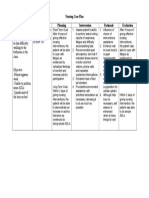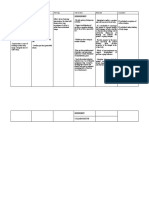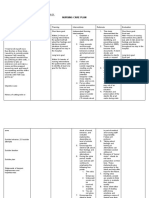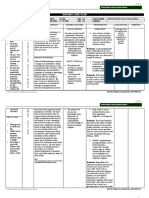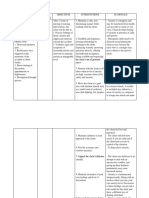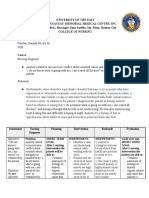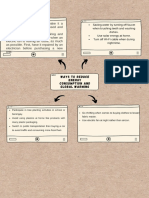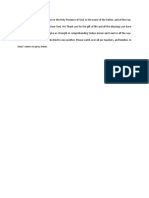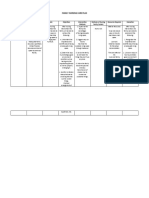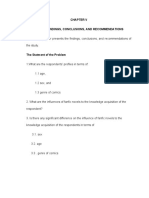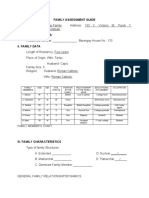0 ratings0% found this document useful (0 votes)
1K viewsAnxiety NCP
Anxiety NCP
Uploaded by
JULIANNE BAYHONThe nursing interventions were aimed at reducing the patient's anxiety related to uncertainty and fear of the unknown by maintaining a calm demeanor, establishing trust, keeping the patient in a quiet low-stimulation environment, educating on treatability of anxiety disorders, initially supporting defenses, monitoring the nurse's own feelings, and staying with the patient during panic attacks with simple directions. However, after 24 hours the goals of being free from injury, discussing feelings, responding to relaxation, reducing anxiety, and being free from attacks were not met.
Copyright:
© All Rights Reserved
Available Formats
Download as DOCX, PDF, TXT or read online from Scribd
Anxiety NCP
Anxiety NCP
Uploaded by
JULIANNE BAYHON0 ratings0% found this document useful (0 votes)
1K views8 pagesThe nursing interventions were aimed at reducing the patient's anxiety related to uncertainty and fear of the unknown by maintaining a calm demeanor, establishing trust, keeping the patient in a quiet low-stimulation environment, educating on treatability of anxiety disorders, initially supporting defenses, monitoring the nurse's own feelings, and staying with the patient during panic attacks with simple directions. However, after 24 hours the goals of being free from injury, discussing feelings, responding to relaxation, reducing anxiety, and being free from attacks were not met.
Original Title
anxiety ncp
Copyright
© © All Rights Reserved
Available Formats
DOCX, PDF, TXT or read online from Scribd
Share this document
Did you find this document useful?
Is this content inappropriate?
The nursing interventions were aimed at reducing the patient's anxiety related to uncertainty and fear of the unknown by maintaining a calm demeanor, establishing trust, keeping the patient in a quiet low-stimulation environment, educating on treatability of anxiety disorders, initially supporting defenses, monitoring the nurse's own feelings, and staying with the patient during panic attacks with simple directions. However, after 24 hours the goals of being free from injury, discussing feelings, responding to relaxation, reducing anxiety, and being free from attacks were not met.
Copyright:
© All Rights Reserved
Available Formats
Download as DOCX, PDF, TXT or read online from Scribd
Download as docx, pdf, or txt
0 ratings0% found this document useful (0 votes)
1K views8 pagesAnxiety NCP
Anxiety NCP
Uploaded by
JULIANNE BAYHONThe nursing interventions were aimed at reducing the patient's anxiety related to uncertainty and fear of the unknown by maintaining a calm demeanor, establishing trust, keeping the patient in a quiet low-stimulation environment, educating on treatability of anxiety disorders, initially supporting defenses, monitoring the nurse's own feelings, and staying with the patient during panic attacks with simple directions. However, after 24 hours the goals of being free from injury, discussing feelings, responding to relaxation, reducing anxiety, and being free from attacks were not met.
Copyright:
© All Rights Reserved
Available Formats
Download as DOCX, PDF, TXT or read online from Scribd
Download as docx, pdf, or txt
You are on page 1of 8
POTENTIAL
Date/Time Cues Objectives of Care Interventions Evaluation
Nursing
Diagnosis
Subjective: Anxiety related 1. Be free from 1. Maintain a calm, GOAL UNMET
April 11, to uncertainty, injury. non-threatening
2019 “I don’t want to die”. fear of the 2. Discuss manner while After 24 hours of nursing
As verbalized by the unknown, and feelings of working with the intervention. The patient
patient. disruption of dread, anxiety, client. Rationale: was not able to attain the
normal routine. and so forth Anxiety is following:
3. Respond to contagious and may
relaxation be transferred from 1. Be free from
techniques health care provider injury.
with a to client or vice 2. Discuss feelings of
decreased versa. Client dread, anxiety, and so
anxiety level. develops feeling of forth
4. Reduce own security in presence 3. Respond to
anxiety level. of calm staff relaxation techniques with
5. Be free from person. a decreased anxiety level.
anxiety attacks. 2. Establish and 4. Reduce own
maintain a trusting anxiety level.
relationship by 5. Be free from
listening to the anxiety attacks.
client; displaying
warmth, answering
questions directly,
offering
unconditional
acceptance; being
available and
respecting the
client’s use of
personal space.
Rationale:
Therapeutic skills
need to be directed
toward putting the
client at ease,
because the nurse
who is a stranger
may pose a threat to
the highly anxious
client.
3. Remain with the
client at all times
when levels of
anxiety are high
(severe or panic);
reassure client of
his or her safety and
security. Rationale:
The client’s safety
is utmost priority. A
highly anxious
client should not be
left alone as his
anxiety will
escalate.
4. Move the client to a
quiet area with
minimal stimuli
such as a small
room or seclusion
area (dim lighting,
few people, and so
on.) Anxious
behavior escalates
by external stimuli.
Rationale: A
smaller or secluded
area enhances a
sense of security as
compared to a large
area which can
make the client feel
lost and panicked.
5. Maintain calmness
in your approach to
the client. The
client will feel more
secure if you are
calm and inf the
client feels you are
in control of the
situation.
Rationale: Provide
reassurance and
comfort measures.
6. Educate the patient
and/or SO that
anxiety disorders
are treatable.
Rationale:
Pharmacological
therapy is an
effective treatment
for anxiety
disorders; treatment
regimen may
include
antidepressants and
anxiolytics.
7. Support the client’s
defenses initially.
Rationale: The
client uses defenses
in an attempt to
deal with an
unconscious
conflict, and giving
up these defenses
prematurely may
cause increased
anxiety.
8. Maintain awareness
of your own
feelings and level of
discomfort.
Rationale: Anxiety
is communicated
interpersonally.
Being with an
anxious client can
raise your own
anxiety level.
Discussion of these
feelings can provide
a role model for the
client and show a
different way of
dealing with them.
9. Stay with the
patient during panic
attacks. Use short,
simple directions.
Rationale: During
a panic attack, the
patient needs
reassurance that he
is not dying, and the
symptoms will
resolve
spontaneously. In
anxiety, the client’s
ability to deal with
abstractions or
complexity is
impaired.
You might also like
- Nursing Care Process (NCP) Risk-Prone Health Behavior PrepartumDocument2 pagesNursing Care Process (NCP) Risk-Prone Health Behavior PrepartumFrederene JavelonaNo ratings yet
- Idoc - Pub Nursing Care Plan For Seizure NCPDocument2 pagesIdoc - Pub Nursing Care Plan For Seizure NCPACERET, IVAN LAURENTINE G.No ratings yet
- Assessment Explanation of The Problem Objectives Nursing Interventions Rationale Evaluation SubjectiveDocument3 pagesAssessment Explanation of The Problem Objectives Nursing Interventions Rationale Evaluation SubjectiveDanica Kate GalleonNo ratings yet
- Nursing Care Plan - AnxietyDocument1 pageNursing Care Plan - AnxietyPauPau100% (3)
- Anxiety Related To Stress HspitaiztionDocument1 pageAnxiety Related To Stress HspitaiztionEunice Lan Sandoval Ardiente100% (3)
- Teething:diaper Dermatitis NCPDocument2 pagesTeething:diaper Dermatitis NCPMARK OLVIER E. MELCHORNo ratings yet
- FAMILY NURSING CARE PLAN - AsthmaDocument1 pageFAMILY NURSING CARE PLAN - AsthmaJULIANNE BAYHON80% (5)
- FAMILY NURSING CARE PLAN - Alcohol DrinkingDocument2 pagesFAMILY NURSING CARE PLAN - Alcohol DrinkingJULIANNE BAYHONNo ratings yet
- FAMILY NURSING CARE PLAN - Presence of Breeding Sites For Insects and PestsDocument2 pagesFAMILY NURSING CARE PLAN - Presence of Breeding Sites For Insects and PestsJULIANNE BAYHON100% (5)
- FAMILY NURSING CARE PLAN - AsthmaDocument1 pageFAMILY NURSING CARE PLAN - AsthmaJULIANNE BAYHON80% (5)
- TLA - Nutrition For Clients With Special NeedsDocument3 pagesTLA - Nutrition For Clients With Special NeedsJULIANNE BAYHON100% (1)
- Specific HeatDocument2 pagesSpecific HeatVanessa Christonette SistosoNo ratings yet
- Assessment Diagnosis Background Knowledge Planning Intervention Rationale Evaluation SubjectiveDocument3 pagesAssessment Diagnosis Background Knowledge Planning Intervention Rationale Evaluation SubjectiveAngelaNo ratings yet
- Risk For InjuryDocument1 pageRisk For Injuryandycamille7No ratings yet
- Planning: NCP #1 Chronic Pain Related To Compression of Spinal Nerves As Evidenced byDocument10 pagesPlanning: NCP #1 Chronic Pain Related To Compression of Spinal Nerves As Evidenced byNicole Anne TungolNo ratings yet
- Backpain NCPDocument3 pagesBackpain NCPxxarrowloverzxxdes23No ratings yet
- La Salle University Nursing Care PlanDocument2 pagesLa Salle University Nursing Care PlanKristine NacuaNo ratings yet
- NCP PowerlessnessDocument6 pagesNCP PowerlessnessopxNo ratings yet
- NCP For HemorrhoidsDocument3 pagesNCP For HemorrhoidsTADURAN RENE MAE ANGELLI F.No ratings yet
- NCP For Acute PainDocument4 pagesNCP For Acute PainimnasNo ratings yet
- NCP Acabo Hypokalemia 1Document2 pagesNCP Acabo Hypokalemia 1Doneva Lyn MedinaNo ratings yet
- NCP Sleep DisturbanceDocument1 pageNCP Sleep DisturbanceIsrael Soria EsperoNo ratings yet
- NCP - AnxietyDocument4 pagesNCP - AnxietyRoyce Vincent Tizon100% (1)
- NCPDocument4 pagesNCPMichelleNo ratings yet
- Acute Pain Related To Effects of Labor and Delivery ProcessDocument3 pagesAcute Pain Related To Effects of Labor and Delivery ProcessrlinaoNo ratings yet
- Body Weakness NCPDocument1 pageBody Weakness NCPtwicetrashNo ratings yet
- NCP Impaired ComfortDocument2 pagesNCP Impaired ComfortGia P. de VeyraNo ratings yet
- Ineffective Airway Clearance - PTBDocument2 pagesIneffective Airway Clearance - PTBIrish Eunice FelixNo ratings yet
- NCP Disturbed Body ImageDocument2 pagesNCP Disturbed Body ImageDoneva Lyn MedinaNo ratings yet
- Risk For Falls As Evidence by Loss of BalanceDocument4 pagesRisk For Falls As Evidence by Loss of BalanceAlexandrea MayNo ratings yet
- Nursing Care Plan: DATE: 6/27/19Document5 pagesNursing Care Plan: DATE: 6/27/19Maricris Tac-an Calising-PallarNo ratings yet
- Assessment Diagnosis Planning Intervention Rationale EvaluationDocument5 pagesAssessment Diagnosis Planning Intervention Rationale EvaluationArian May MarcosNo ratings yet
- Nursing Care Plan - Fatigue (Antepartum)Document3 pagesNursing Care Plan - Fatigue (Antepartum)kaimimiyaNo ratings yet
- Nursing Care Plan HemorroidsDocument2 pagesNursing Care Plan HemorroidsCaryl CagampangNo ratings yet
- Disturbed Sleep Pattern Related To Environmental FactorsDocument9 pagesDisturbed Sleep Pattern Related To Environmental Factorsalaisah dimaporoNo ratings yet
- Assesment Diagnosis Planning Interventio N Rationale EvaluationDocument2 pagesAssesment Diagnosis Planning Interventio N Rationale EvaluationRenea Joy ArruejoNo ratings yet
- A.) 62 Yo Male, S/P (Status Post) Exploratory Laparotomy Secondary Intestinal ObstructionDocument4 pagesA.) 62 Yo Male, S/P (Status Post) Exploratory Laparotomy Secondary Intestinal ObstructionKate Aenyle AgsoyNo ratings yet
- NURSING DIAGNOSIS (2) On Pregnant Woman Knowledge DeficitDocument2 pagesNURSING DIAGNOSIS (2) On Pregnant Woman Knowledge Deficitanon_168410816No ratings yet
- NCP Acute Pain-HyperthermiaDocument6 pagesNCP Acute Pain-HyperthermiarhegellNo ratings yet
- FATIGUE NCP Que Fransis A.Document4 pagesFATIGUE NCP Que Fransis A.Irene Grace BalcuevaNo ratings yet
- Impaired Physical Mobility Related To Pain and DiscomfortDocument2 pagesImpaired Physical Mobility Related To Pain and DiscomfortRis NapolisNo ratings yet
- NCP Pain Post CsDocument1 pageNCP Pain Post Csrholiboi50% (2)
- Nursing Care Plan For AsthmaDocument1 pageNursing Care Plan For AsthmaDianne MaeNo ratings yet
- NCP HypertensionDocument1 pageNCP HypertensionCharisse VillanuevaNo ratings yet
- NCPDocument4 pagesNCPyasayayasay yasayNo ratings yet
- Skin IntegrityDocument2 pagesSkin IntegrityJonica CamposNo ratings yet
- Disturbed Sleeping Pattern NCPDocument4 pagesDisturbed Sleeping Pattern NCPSamVelascoNo ratings yet
- NCP AlteredDocument3 pagesNCP AlteredShaira TillahNo ratings yet
- Assessment Diagnosis Planning Intervention Rationale EvaluationDocument2 pagesAssessment Diagnosis Planning Intervention Rationale EvaluationRomeo Avecilla CabralNo ratings yet
- DeficientDocument2 pagesDeficientVANNEZA TRIXZY TAMPARONGNo ratings yet
- Acute Pain NCPDocument1 pageAcute Pain NCPJed AvesNo ratings yet
- Delayed Growth NCPDocument3 pagesDelayed Growth NCPPau-pau BasiNo ratings yet
- Disturbed Sleep pattern-NCPDocument2 pagesDisturbed Sleep pattern-NCPLADY CLAIRE DOBLENo ratings yet
- Nursing Care Plan Borderline PD (Client A) NCP #1: Pia Mae D. Buaya N-31Document9 pagesNursing Care Plan Borderline PD (Client A) NCP #1: Pia Mae D. Buaya N-31Pia Mae BuayaNo ratings yet
- Ineffective Health MaintenanceDocument6 pagesIneffective Health MaintenanceRYAN SAPLADNo ratings yet
- Nursing Care Plan - Risk For Falls (Antepartum)Document2 pagesNursing Care Plan - Risk For Falls (Antepartum)kaimimiyaNo ratings yet
- NCP AppendicitisDocument4 pagesNCP AppendicitisAisha LakibulNo ratings yet
- Nursing Care Plan PATIENT NAME: - AGE: 22: PowerlessnessDocument4 pagesNursing Care Plan PATIENT NAME: - AGE: 22: PowerlessnessGhale Annetoinette ReyesNo ratings yet
- NCP Sleep PatternDocument3 pagesNCP Sleep PatternRA Balaoing100% (1)
- Ate Gara NCP (Activity Intolerance)Document2 pagesAte Gara NCP (Activity Intolerance)Kimsha ConcepcionNo ratings yet
- NCP For ROMDocument7 pagesNCP For ROMampalNo ratings yet
- Assessment Diagnosis Background Knowledge Planning Intervention Rationale EvaluationDocument6 pagesAssessment Diagnosis Background Knowledge Planning Intervention Rationale Evaluationnipheyy dananNo ratings yet
- NCM117 NCPDocument2 pagesNCM117 NCPHANNAH MICOLE GAERLANNo ratings yet
- Lucie Fink NCPsss - BUAYA PIA N32Document7 pagesLucie Fink NCPsss - BUAYA PIA N32Pia Mae BuayaNo ratings yet
- Schiz NCPDocument5 pagesSchiz NCPCharisse LuteroNo ratings yet
- Panic Attack Nursing Care PlanDocument4 pagesPanic Attack Nursing Care PlanSamVelasco100% (2)
- Research 12 Mins VidDocument3 pagesResearch 12 Mins VidJULIANNE BAYHONNo ratings yet
- Marie RRL 1Document3 pagesMarie RRL 1JULIANNE BAYHONNo ratings yet
- Article Bayhon WardDocument7 pagesArticle Bayhon WardJULIANNE BAYHONNo ratings yet
- UntitledDocument2 pagesUntitledJULIANNE BAYHONNo ratings yet
- 22ND JournalDocument6 pages22ND JournalJULIANNE BAYHONNo ratings yet
- Reporting Script Content of ThoughtDocument4 pagesReporting Script Content of ThoughtJULIANNE BAYHONNo ratings yet
- HypoDocument1 pageHypoJULIANNE BAYHONNo ratings yet
- Acute Pain Related To Inflammation and Distension of The Colon.Document2 pagesAcute Pain Related To Inflammation and Distension of The Colon.JULIANNE BAYHONNo ratings yet
- Trimetazidine Drug StudyDocument2 pagesTrimetazidine Drug StudyJULIANNE BAYHON100% (2)
- Introduction, Objectives NCP1Document5 pagesIntroduction, Objectives NCP1JULIANNE BAYHONNo ratings yet
- Blue and White Modern Photo Engineering ResumeDocument1 pageBlue and White Modern Photo Engineering ResumeJULIANNE BAYHONNo ratings yet
- Pitch Deck 6th EditDocument14 pagesPitch Deck 6th EditJULIANNE BAYHONNo ratings yet
- Japanese IntroductionDocument2 pagesJapanese IntroductionJULIANNE BAYHONNo ratings yet
- Quiz 1: GroupDocument8 pagesQuiz 1: GroupJULIANNE BAYHONNo ratings yet
- UntitledDocument1 pageUntitledJULIANNE BAYHONNo ratings yet
- Biochem Lab QuipperDocument4 pagesBiochem Lab QuipperJULIANNE BAYHONNo ratings yet
- Review of Related LiteratureDocument3 pagesReview of Related LiteratureJULIANNE BAYHONNo ratings yet
- Let's Check (Part 2) - BayhonDocument1 pageLet's Check (Part 2) - BayhonJULIANNE BAYHONNo ratings yet
- FAMILY NURSING CARE PLAN - Faulty Eating HabitsDocument2 pagesFAMILY NURSING CARE PLAN - Faulty Eating HabitsJULIANNE BAYHON100% (1)
- C3 CabacunganDocument3 pagesC3 CabacunganJULIANNE BAYHONNo ratings yet
- Family Nursing Care Plan - Inadequate Living SpaceDocument2 pagesFamily Nursing Care Plan - Inadequate Living SpaceJULIANNE BAYHON67% (3)
- Let's Check (Part A) - BayhonDocument1 pageLet's Check (Part A) - BayhonJULIANNE BAYHONNo ratings yet
- FAMILY NURSING CARE PLAN - Faulty Eating HabitsDocument2 pagesFAMILY NURSING CARE PLAN - Faulty Eating HabitsJULIANNE BAYHON100% (1)
- Summary of Findings, Conclusions, and RecommendationsDocument4 pagesSummary of Findings, Conclusions, and RecommendationsJULIANNE BAYHONNo ratings yet
- Family Assessment Guide: Family Member'S ChartDocument6 pagesFamily Assessment Guide: Family Member'S ChartJULIANNE BAYHONNo ratings yet
- CA Ramakrishna CVDocument2 pagesCA Ramakrishna CVCA Madhu Sudhan ReddyNo ratings yet
- The Globe Issue No 38Document12 pagesThe Globe Issue No 38The Globe NewspaperNo ratings yet
- Chin CD CoverDocument32 pagesChin CD CoverJared RedmondNo ratings yet
- The Bretton Wood System-2Document11 pagesThe Bretton Wood System-2Ashwin RacerNo ratings yet
- Robert K. Merton, Norman W. Storer (Ed.) - The Sociology of Science - Theoretical and Empirical Investigations-University of Chicago Press (1979)Document630 pagesRobert K. Merton, Norman W. Storer (Ed.) - The Sociology of Science - Theoretical and Empirical Investigations-University of Chicago Press (1979)Diana50% (2)
- White Label WhatsApp Chatbot by Bot PenguinDocument8 pagesWhite Label WhatsApp Chatbot by Bot PenguinbotpenguinseoNo ratings yet
- DLL - Tle-He 6 - Q1 - W5Document6 pagesDLL - Tle-He 6 - Q1 - W5Maricel PurisimaNo ratings yet
- Edn2101 Task 2Document3 pagesEdn2101 Task 2api-372464959No ratings yet
- 403 - 404 - 405 - 406 - 407 - 408 - 409 - Generation (Vermontelectric - Coop)Document9 pages403 - 404 - 405 - 406 - 407 - 408 - 409 - Generation (Vermontelectric - Coop)LEON SOTNASNo ratings yet
- Campus Software EngineerDocument3 pagesCampus Software EngineerChikku akshayNo ratings yet
- 2005 Skareb Service ManualDocument30 pages2005 Skareb Service Manualmaykel araujoNo ratings yet
- Liu006 Dealing With MoneyDocument2 pagesLiu006 Dealing With MoneyGaik Heok TanNo ratings yet
- General Notices and Requirements: Index To USP 39-NF 34Document71 pagesGeneral Notices and Requirements: Index To USP 39-NF 34Asifa ShabbirNo ratings yet
- Offensive Technologies: Attacking Android's Pattern & PIN LockDocument23 pagesOffensive Technologies: Attacking Android's Pattern & PIN LockjakiniNo ratings yet
- Hoàng Writing 2Document4 pagesHoàng Writing 2Ngọc Pe PeNo ratings yet
- Sontek Adv in Fluid Mud Exp VerificationDocument19 pagesSontek Adv in Fluid Mud Exp VerificationKarthik RNo ratings yet
- 99ACRES RENT Sector 82A GurugramDocument7 pages99ACRES RENT Sector 82A GurugramArunoday DevganNo ratings yet
- Kuwait University: Student NameDocument6 pagesKuwait University: Student NameabdalwhabNo ratings yet
- Submerged Arc WeldingDocument2 pagesSubmerged Arc WeldingcalcedaNo ratings yet
- Les Preludes ReportDocument4 pagesLes Preludes ReportAngella ListaNo ratings yet
- Diagnostic Exam For 7th GradeDocument11 pagesDiagnostic Exam For 7th GradeMariana Garza NaranjoNo ratings yet
- Commercial Drainage Facility Maintenance ChecklistDocument2 pagesCommercial Drainage Facility Maintenance ChecklisttmamputsiNo ratings yet
- Best Melodic Dubstep Mix 2013 - YouTubeDocument4 pagesBest Melodic Dubstep Mix 2013 - YouTubeorangotaNo ratings yet
- Rubrics-Sandwich MakingDocument1 pageRubrics-Sandwich MakingGillian Abiera100% (2)
- PIOs - and - FAAs - As - On - 22june 2020Document74 pagesPIOs - and - FAAs - As - On - 22june 2020Ashish Singh bhandariNo ratings yet
- Varsity Chronicles - by Leader TapfumaDocument33 pagesVarsity Chronicles - by Leader TapfumaLeader TapfumaNo ratings yet
- Energy Risk Professional (Erp) Examination: Practice Exam 1Document53 pagesEnergy Risk Professional (Erp) Examination: Practice Exam 1James WaltonNo ratings yet
- Post Test of TOEFL For PrivateDocument23 pagesPost Test of TOEFL For PrivateimtyazulhikmahhalimahNo ratings yet
- Karnataka Electricity Board:: 1) KPCL (Karnataka Power Corporation Limited) :in KPCL We HaveDocument31 pagesKarnataka Electricity Board:: 1) KPCL (Karnataka Power Corporation Limited) :in KPCL We Havesunitha vNo ratings yet
























